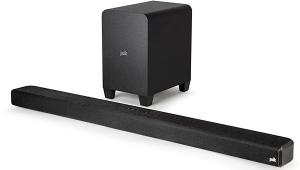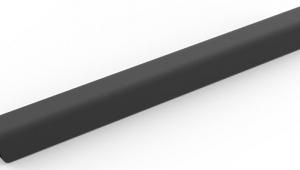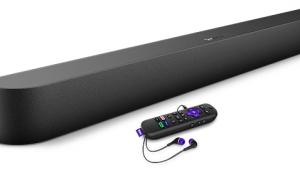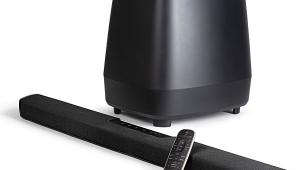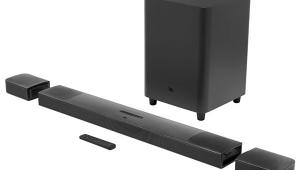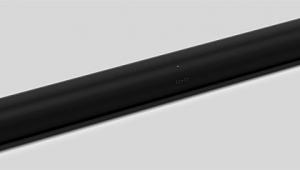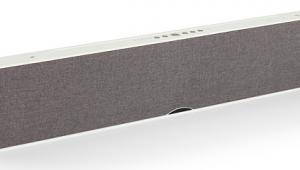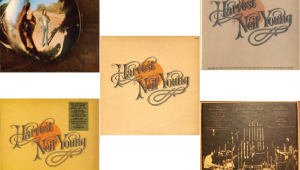Bit baffled this was rated so high on this website, check the Sonos community, lots of complaints on the sound quality of this product. ALso Rtings scored this sound bar low so makes you wonder why the difference.
Sonos Arc Soundbar Review Page 2
Once that's all done, the app steps you through joining it to your Alexa or Google Home account, and you then sign into your favorite streaming music accounts so Sonos can access them. The last step is to run the Sonos Trueplay routine to adapt the Arc to your room boundaries—a critical step given the Arc's reliance on the walls and ceiling to reflect sound.
For my auditions, I placed Arc about a foot below at my sitting ear-level to ensure optimal sound quality. I played 5.1-channel Dolby and Atmos soundtracks as well as DTS from my streaming devices and discs. Note that since there is no onboard DTS decoder, multichannel DTS soundtracks must be sent by your source in two-channel PCM format. (Sonos has never put discrete DTS decoding in its soundbars, presumably because Dolby is universal to all sources and only a minority of users will use Blu-ray discs for playback.) To assess the Arc's music chops, I listened to CD-quality streams from Tidal and some CDs via my disc player. I listened first to the bar alone, then with the surrounds, then added the Sub to assess the improvements as I went along.

Performance
Whether I served the Arc simple stereo music, a multichannel Dolby Digital soundtrack, or full-on Dolby Atmos, I found it to be an impressive and capable performer either alone or with its companion surrounds and subwoofer. The sound of the bar by itself can be characterized as being exceptionally smooth and unveiled in the midrange right on up through the highs—I was pleased to hear clarity in the upper registers with none of the supressed detail that sometimes accompanies cloth-dome tweeters. And yet, the Arc's cloth-dome friendliness kept bright soundtracks palatable and unfatiguing even at a loud volume.
At the other end of the frequency range, test tone sweeps suggested an extremely even transition from the midrange down to the bar's lower limit. With the app's bass tone control set to its 0 default and the default Loudness compensation turned off, the bar added a tiny blip of extra energy somewhere in the 100 to 250 Hz range, but hardly enough to sound bloated or over-enhanced. Goosing the bass slider gave it a touch more fullness, but I didn't overdo it. In my fairly large studio space, the usable bass stayed remarkably present and consistent right down to about 60 Hz, where it abruptly fell off. You might do better if the bar is placed nearer to room boundaries than I'm able to do in my setup, but let's be clear: 60 Hz is pretty damn good for a standalone soundbar. It was enough to make the Arc a serious rig for most music and typical TV viewing, though not quite enough to deliver a fully balanced and impactful home theater experience with movies. This doesn't mean it was a letdown with action flicks, only that it was ultimately limited in what it could do with bass-heavy effects.
With all of its drivers working, the bar created a beautifully broad image with stereo music tracks, one that went almost wall-to-wall in my 11-foot wide viewing area and easily reached up to the relatively ceiling in the finished basement of my 90-year-old home. Centered vocalists and soloists projected well forward of the bar, and from my 10-foot listening distance the system hit 92 dB peaks with no obvious distortion.
The Arc's easy and unfettered mids and highs were apparent on a jazzy rendering of "I Remember You" by the Elmo Hope Trio. Hope's piano notes floated out in the room with palpable body and natural timbre, while the brushed snare accompaniment retained its fine, papery detail and the standup bass provided a sufficiently full and tuneful undercurrent. Tracks recorded with an audience, such as Luther Vandross doing "A House Is Not A Home" on Live At Radio City Music Hall 2003, rendered a nice one-third dome of applause that imparted a sense of ambience but couldn't reach far enough to put you in the hall. Still, it was a spacious and engaging effect.

More dynamic, well-recorded pop tracks such as "What I Can Do for You" from Sheryl Crow's classic Tuesday Night Music Club album proved the Arc capable of letting its hair down. Vocals were portrayed as big and solid, and the bar did a respectable job with the song's driving kick drum, though its low-end limits made it a less visceral experience than I'm used to hearing from my sub-supported reference system.
Movie soundtracks enjoyed the same benefits of the Arc's well-balanced and open sonics, as well as the same drawbacks of limited bass and restricted depth that can be attributed to any up-front soundbar operating without dedicated rear surrounds. Playing discrete Dolby Digital 5.1 and Dolby Atmos 5.1.2 pink noise tones from test discs was instructive in showing what Sonos engineered the bar to do with multichannel signals. No matter what channel was sent to the bar, all the drivers were actively working, but the noise always emanated from a fixed location. The main left and right channels were stationed beyond the left and right endcaps after taking advantage of room reflections, and the center channel was locked solidly to the middle. The left/right rear surround information came from essentially the same locations as the main left/right channels at the front of the room but sounded a touch more spacious. On the other hand, the front height information present in a 5.1.2 Atmos signal was impressively anchored on the ceiling about a third of the way back toward my seating...precisely where it should be. (The rear height information in a 5.1.4 test signal fell in precisely the same location.)
And Then There Was Sub
Given the placements of the virtual speakers, it was no surprise that the bar by itself playing regular 5.1 Dolby Digital soundtracks exhibited a wide and tall soundstage with reasonable depth and some wrapping of sound on the side walls, but none of the rear fill you'd normally get with surrounds. And while the bottom end was serviceable and perhaps enough for many viewers, it wasn't nearly enough in my room to balance out the Arc's excellent and dynamic playback above that 60 Hz mark. Adding the Play:1 speaker pair as surrounds made an enormous difference, both by expanding the soundfield fully to the back of the room and allowing greater delineation of instruments and sound objects in a manner that, I thought, seemed to strengthen the bass presence even without adding the Sub. When I finally did so, it took the system to yet another level.

The early attack and crash scene in the Blu-ray of Star Trek Beyondthat sees the Enterprise boarded by Krall's soldiers and eventually destroyed has an expansive mix of surround effects. Even in Dolby Digital 5.1 with no surrounds or subwoofer, this was an impressive sequence on which the Arc delivered a solid wall of sound up front that offered all manner of creaking metal, traveling phaser fire, explosions, and other mayhem set against dialogue that was clear enough that I never needed to invoke the Sonos app's speech enhancement mode. But the rear effects never reached terribly far back to create a sense of envelopment. Switching to the disc's Atmos track, which added the well-placed virtual height speakers and its discrete effects, noticeably expanded the surround bubble forward but still left it well short of the back of the room. The sound also benefited from a welcome jump in dynamics and openness as a consequence of moving to the lossless TrueHD base.
Switching in the surrounds with either the 5.1 or Atmos tracks added a tremendous sense of dimensionality and a continuous bubble that allowed effects like a fragment swarm that engulfs the ship to pan from front to back. With the Atmos version, however, a full dome of sound was generated and those fragments were able to pass right through the viewer. Music was also greatly transformed with the addition of the surrounds. The app's Ambient surround option for music always seemed to steer just the right elements in just the right amounts to the rears; on the Luther Vandross track mentioned earlier it put me literally in the middle of the audience with applause coming from behind and in front. Once the surrounds were present, Atmos music tracks were also a home run: watching a video for the techno track "Swivel" by London Elektricity amounted to a near-hypnotic experience.
It should go without saying that adding the Sub addressed any lack of bass with either music or movies and allowed the bar to play louder and cleaner. With the subwoofer installed, the test tones revealed usable and very taut bass down to about 35 Hz, and the Arc took firm command not only of any and all action effects such as the rumbling of an approaching squadron of WWI bomber and fighter planes in Unbroken, but demanding music as well. The R&B track "Still" by Donnell Jones from Life Goes On has some stupendously low bass. The song sounded reasonably full and impactful on the bar alone, but adding the sub took it right into chest-compression territory. Now, that's what I'm talkin' about.
Conclusion
Most folks would say $799 is a lot for a soundbar, especially one that doesn't ship with a subwoofer or surrounds. But the Sonos Arc is a brilliantly engineered and worthy successor to the Playbar that sounds amazing with movies and TV, and, critically for Sound & Vision readers, delivers a truly respectable audiophile experience with music. The excellent Sonos multiroom music platform on which the company was built here becomes the icing on the cake.
As with any soundbar that relies on room boundaries, the Arc's bass extension and its success at rendering surround sound will be dependent on your space. The Sub subwoofer is a recommended option. And given how effectively the Arc projected Atmos height information, I'd strongly suggest popping for rear speakers to complete the effect and experience Atmos as it's truly meant to be heard. Oh, I'm betting you'll love Arc even without the surrounds. But they are a transformative add and successfully drive home what Sonos has accomplished here in a fairly svelte soundbar—a very near equivalent to a discrete Dolby Atmos system, and one heck of a fun ride.
- Log in or register to post comments


No soundbar is worth $800. Period.

Trying demo'ing a Samsung HW-Q90R with the right content. If you can score it for below $1000, it's a steal. Now granted, it's a complete system... not just 'a soundbar' but it out performs many a full-on HT AVR arrangement in the price segment.




